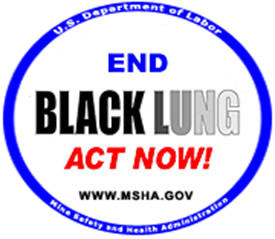Lower Respirable Dust Standard Now Effective in U.S. Coal Mines

Today, August 1, 2016, is the effective date of the new, lower limit on coal-mine dust in American mines. This reduction is expected to reduce the occurrence of black lung. This is the start of a new, safer period in dust conditions for coal miners, but does not eliminate the need for vigilance in the continuing fight against black lung.
According to the Department of Labor’s estimates, lowering the dust limit should prevent hundreds of cases of black lung. For example, the lower dust standard (combined with a change in sampling methodology) will prevent an estimated 593 miners from getting category 1 coal workers’ pneumoconiosis, 319 miners from getting severe black lung (progressive massive fibrosis or PMF), and 248 miners from getting severe emphysema after a career as an underground miner. The net benefit of this health improvement (after taking into account costs of compliance) is estimated to be worth $12.1 million per year. (see 79 Fed. Reg. at 24,959–60).
The change was made by the U.S. Department of Labor’s Mine Safety and Health Administration (MSHA)’s 2014 dust rule (see previous post here from when rule was released.) Although the rule was published in May 2014, it was designed to allow the coal industry a couple of years to prepare for the reduction in dust standards.
The new rule amended 30 C.F.R. § 70.100(a) to say the following:
(a) Each operator shall continuously maintain the average concentration of respirable dust in the mine atmosphere during each shift to which each miner in the active workings of each mine is exposed, as measured with an approved sampling device and expressed in terms of an equivalent concentration, at or below:
(1) 2.0 milligrams of respirable dust per cubic meter of air (mg/m³).
(2) 1.5 mg/m³ as of August 1, 2016.
As previously covered on this blog, the U.S. Court of Appeals for the Eleventh Circuit upheld the rule against a pre-enforcement challenge filed by the National Mining Association.
Since the rule was published in 2014, MSHA has been tracking coal operators’ dust results. According to a recent release by MSHA, 98% of the industry’s samples would meet the new 1.5 mg/m³ standard. This shows that better protecting miners from black lung is feasible for the industry.
Today is that start of a new period in American coal mines. The dust limit had not previously been adjusted since 1972 even though thousands of American miners continue to contract black lung disease.
Today’s reduction is a step in the right direction but will not end the fight against black lung. For one, it must be remembered that NIOSH recommended that the dust levels be reduced to 1.0 mg/m³. Today’s change only takes us half way to where the public health experts recommended the standard be set to protect coal miners. In addition, while MSHA has improved its sampling methodology and the continuous personal dust monitor (“CPDM”) provides better data to miners and regulators, the potential for dust fraud cannot be forgotten. (For two recent examples of stories regarding dust fraud since MSHA’s rule was published, see here and here.) The community of coal miners, public health advocates, and watchdogs is going to have a necessary and continuing role to monitor how the dust rule is implemented and complied with.
But with that being said, coal miners working from today onwards should be exposed to less dust and that is—irrefutably—a good thing.